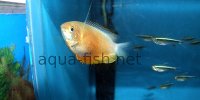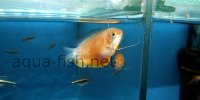The Dwarf Gourami - Aquarium Setup and Proper Care
This is a guide on raising, feeding and breeding Dwarf gouramis; Simply scroll down and in case you can't find answer on your question, simply use a form at the bottom to ask us! You might be interested in visiting this page too: Dwarf gourami - Colisa lalia profile with forum. The Dwarf Gourami is one of the small members of the Gourami family. Males are a little bit larger than the females, reaching up to 6 cm (2.36 inch) in length. In the wild the male is very colorful while the female is less colored. There are several color variations, including Blue/Powder Blue, Neon, Rainbow, and Red/Blushing. Dwarf Gouramis are Labyrinth Fish, meaning they breath directly from the air, so they must have access to the surface. It is recommended to keep them in a tank that is more than 15 US USgallons (roughly 57 liters, 12.5 Imperial gallons) in size. Water conditions in the tank should be stable with pH between 6.5 and 8.0, temperature from 23.0 to 28.0 °C (73.4 - 82.4 °F) and water hardness dGH of 4.0 - 18.0 °N. Keep the water conditions within acceptable intervals and these fish won't be sick, won't be stressed and will behave as naturally as a fish in an aquarium can. Because of their peaceful and shy nature and ease of care, they are well suited to smaller aquariums, as well as community aquariums. As they're peaceful, it is quite rare for two or more males to fight for territories. In fact, this occurs when fish are kept in small tanks, if there are not enough plants present in the tank, or if only 1 female lives with 4 or more males. Simply grow more plants in your fish tank, offer your fish lots of driftwood and tall decorations including caves and rocks. Also, the truth is, that they should not be kept with very large or aggressive fish. They need plenty of vegetation, including floating plants that cover part of the surface of the water. On the one hand the Dwarf Gourami enjoys each other’s company if they are mixed and matched with a group of at least three males and about twice as many females. On the other hand the fact is that some males can be over nervous and spend most of their time hiding. If there is a pair of the fish, they will swim together. The Dwarf Gourami is native to India, specifically found in regions such as West Bengal, Assam, and Bangladesh, where it inhabits densely vegetated aquatic environments. It is commonly observed swimming alongside other species of the Colisa genus. In their natural habitat, Gouramis typically feed on small insects and larvae found on the water's surface, as well as graze on algae that grows on aquatic plants. In aquarium settings, they readily consume flake food, freeze-dried options like blood worms (which are essentially mosquito larvae), frozen foods, and vegetable tablets. To ensure optimal health, occasional feedings of live foods such as worms are recommended. Live foods are also beneficial for conditioning breeding pairs. It's important not to overfeed Dwarf Gouramis. The recommended feeding regimen is to offer an amount of food that can be consumed within a maximum of 5 minutes, once a day. Juveniles may require feeding two or three times daily, while fry may need even more frequent feedings, up to 5-6 times a day. If you're housing only two specimens, feeding once a day with an amount that can be consumed in a minute or two is sufficient, as it minimizes competition for food. However, with more specimens, additional feeding time may be necessary to ensure that all fish have access to food. Male Dwarf Gouramis construct floating bubblenests, necessitating the presence of floating plants in the tank. Maintain the water temperature around 82°F (approximately 28°C) once the nest is built. Following spawning, it's advisable to relocate the female to a separate tank if the main tank lacks sufficient space. Therefore, it's recommended to house Dwarf Gouramis in a spacious tank with numerous hiding spots. While the male initially cares for the eggs and fry, his attentiveness usually wanes after the fry reach 2-3 days of age. As the fry become independent swimmers, begin feeding them infusoria, gradually transitioning to brine shrimp and finely ground flakes. As they mature, incorporate freeze-dried tablets into their diet. An often asked question among fish keepers is "How frequently do dwarf gouramis breed?". Typically, they can breed once a month or once every two months. However, it's common for them to attempt spawning as frequently as possible over a period of, for instance, three months, followed by a break. Subsequently, they may resume their spawning behavior. Their breeding frequency is influenced by food availability, although consistently feeding them earthworms may diminish their response to this stimulus. In such cases, the female may become fatigued, resulting in decreased breeding activity. Sexing Dwarf Gouramis is a vital aspect of successful breeding because two males won't reproduce. Sexing has been mentioned previously at the top of this page, but let's recapitulate it once more. Like all other Gouramis, males are longer and slimmer than females. The colors of females aren't as vibrant as those of males. Although Dwarf Gouramis belong to peaceful species, males tend to be more territorial. Consequently, it's relatively easy to maintain around 6-7 specimens in an 80-liter aquarium. Once they've hatched, they can potentially live up to 4 years if properly cared for. On average, aquarists report a lifespan of 2-3 years.

Quick links - Answers
Brief Description
Aquarium setup
Origin
Feeding Dwarf Gouramis
Breeding Dwarf Gouramis



